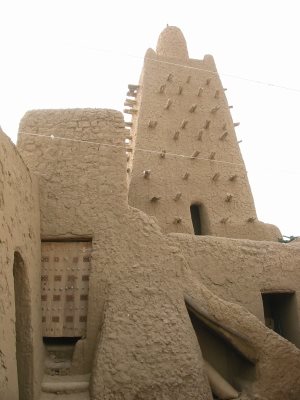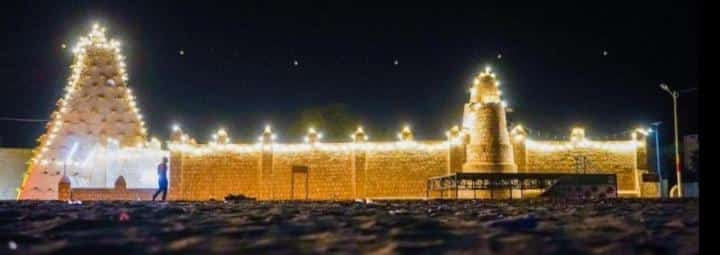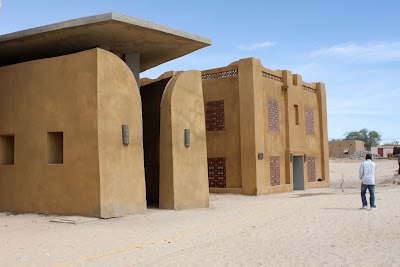Tuareg Cultural Center (مركز الثقافة الطوارقية)
Overview
The Tuareg Cultural Center, nestled in the heart of the Tombouctou Region in Mali, stands as a vibrant testament to the rich heritage and fascinating history of the Tuareg people. Often referred to as "the blue people of the Sahara" due to their distinctive indigo-dyed garments, the Tuareg have embraced a nomadic lifestyle in the desert for centuries. This cultural center serves as both a museum and a living exhibition, celebrating their age-old traditions, art, and way of life.
Visitors are welcomed by the center’s striking architecture, designed to harmonize with the surrounding desert landscape. Crafted using traditional materials and techniques, the building reflects the Tuareg’s deep respect for their environment and resourcefulness. Inside, the center is thoughtfully divided into various sections, each offering a unique glimpse into the multifaceted world of Tuareg culture.
One of the main attractions is the hall dedicated to Tuareg art, where you can explore intricately crafted jewelry, exquisite leatherwork, and detailed metalwork. These exquisite pieces showcase the incredible craftsmanship for which the Tuareg are renowned. The designs often incorporate significant symbols and motifs, reflecting their deep spiritual connections and rich storytelling heritage.
The center also boasts an extensive collection of traditional Tuareg clothing. The famous indigo-dyed robes and veils, collectively known as "tagelmust," are displayed in all their glory. These garments are not only visually stunning but serve practical purposes, offering protection against the harsh desert elements. Visitors can gain insight into the dyeing process, which involves natural indigo and is a painstaking, time-honored tradition passed down through generations.
Another highlight is the section dedicated to Tuareg history and daily life, providing a compelling narrative of their journey as a people. Through a series of well-curated exhibits, visitors can trace the origins of the Tuareg, their migratory patterns across the Sahara, and their interactions with diverse cultures and civilizations. This area also delves into the social structures within Tuareg society, where clan affiliations, kinship, and age-old customs play significant roles.
An essential part of the Tuareg Cultural Center is its storytelling sessions. Oral tradition is a cornerstone of Tuareg culture, and these sessions present a rare opportunity to hear folktales and histories recounted by renowned Tuareg storytellers. Often accompanied by traditional music played on instruments like the "imzad" (a one-stringed fiddle) and the "tendé" (a drum), these stories bring the past to life, offering profound insights into Tuareg philosophy and worldviews.
The center's library is another treasure trove, housing ancient manuscripts and modern works that chronicle Tuareg history, language, and literature. Some manuscripts date back centuries and are written in Tifinagh, the ancient script of the Tuareg. Scholars and tourists alike can delve into these texts, exploring the intellectual pursuits of a people often mistakenly assumed to be purely nomadic warriors.
In addition to its exhibits, the Tuareg Cultural Center hosts a variety of cultural events and workshops. These activities range from traditional dance and music performances to hands-on workshops in Tuareg crafts and survival skills essential for desert life. Participating in these events offers a deeper understanding and appreciation of Tuareg culture while providing a fun and interactive experience for visitors of all ages.
A visit to the Tuareg Cultural Center would be incomplete without savoring the local cuisine. The on-site café offers a taste of Tuareg culinary traditions, featuring dishes made with millet, dates, and goat meat, often accompanied by refreshing mint tea. These meals are not only delicious but also showcase the Tuareg’s remarkable adaptation and resourcefulness in thriving within one of the world’s most challenging environments.
For those looking to take a piece of Tuareg culture home, the center’s gift shop offers a selection of authentic crafts, including jewelry, textiles, and pottery. Purchasing these items supports local artisans and promotes the continuation of traditional crafts.
In conclusion, the Tuareg Cultural Center in the Tombouctou Region is much more than just a museum; it is a living, breathing homage to a remarkable culture. It stands as a beacon of cultural preservation, offering an immersive experience that informs, engages, and inspires. Whether you are a history enthusiast, an art lover, or simply a curious traveler, the Tuareg Cultural Center promises an unforgettable journey into the heart of the Sahara and the soul of the Tuareg people.






